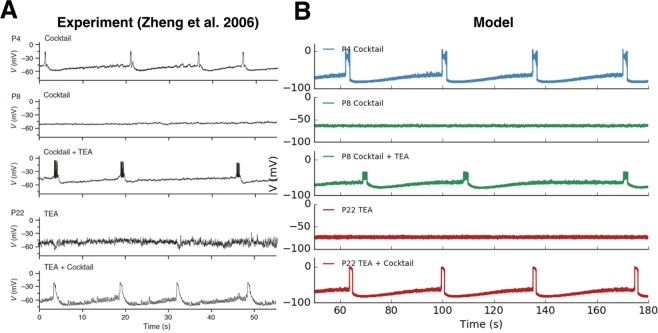Figure 10.
(A) Pharmacological manipulations made by6 in order to restore bursting activity in rabbit SACs at different ages. (B) Varying the potassium conductance gK and the half-activation potential V3 changes the excitability of SACs in our model. Blue: Modeling the bursting activity of isolated P4 SAC, gK = 8 nS, V3 = −16 mV. Green top: Modeling P8 isolated SACs where we see no bursting activity, gK = 10 nS, V3 = −34 mV. Green bottom: Decreasing gK = 8 nS, V3 = −34 mV we restore oscillations. Red top: Modeling P22 coupled SAC where there is no bursting activity upon treatment with TEA. An inhibitory current Iext = −10 pA is applied to coarsely mimic the inhibitory input to SAC at this stage of development. To account for the TEA application we take decrease the conductance gK = 4.5 nS (V3 = −35 mV). Red bottom: Restoration of bursting at P22 by removing all inhibitory synaptic connections, Iext = 0 pA. Removing inhibition from mature amacrine circuitry, along with blocking a subfamily of K+ channels with TEA, is enough to re-initiate bursting activity. The values proposed here for V3, gK are only indicative, as the same behavior is observed in a wide range of parameters (see the bifurcation diagram in Fig. 11).

